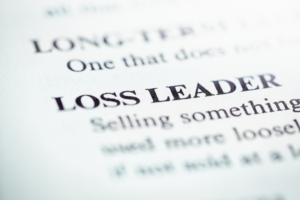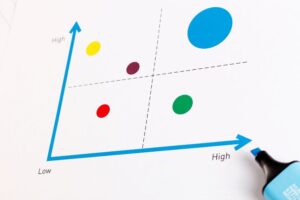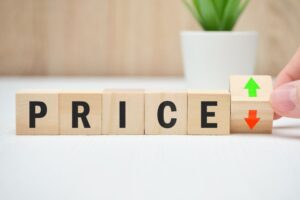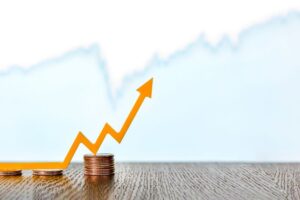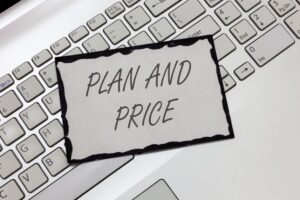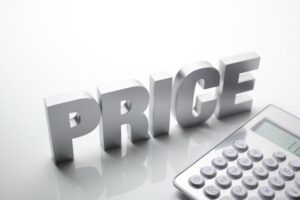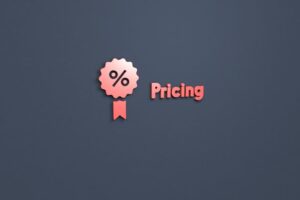Have you ever wondered why certain products or services are priced at $9.99 instead of $10 or why some prices are written in red? These are examples of psychological pricing strategies that businesses use to influence consumer behavior.
Research has shown that 9-ending prices are usually higher than non-9-ending prices, yet customers are willing to pay more for such products. Strategies like this exert a profound effect on decision-making. Hence, understanding the psychological pricing definition can help you boost your sales and increase your revenue.
In this article, we’ll delve deeper into what psychological pricing is and how it works. We’ll explore different psychological pricing strategies and examine the mental factors driving consumer behavior. Finally, you’ll learn how to implement this strategy in your business or spot it as a business tactic.
What is Psychology Pricing?
Psychological pricing is a marketing strategy involving specific cognitive and emotional tactics influencing consumer behavior. The goal is to create a perception of value, urgency, or exclusivity that appeals to customers’ emotions and psychology, making them more likely to buy.
Psychological pricing uses various mental tools to impact consumer behavior. One of these tools is using colors such as red, which creates a sense of urgency and can make customers feel more impulsive. Another tool is the concept of perceived value, which is how customers evaluate the worth of a product based on its price.

Types of Psychological Pricing (With Examples)
There are various psychological pricing strategies, and each one works differently to impact consumer behavior. These techniques include:
- Artificial time constraints
- Charm pricing
- Innumeracy
- Prestige pricing
- Price appearance
- Decoy pricing.
1. Artificial Time Constraints
Artificial time constraint is a psychological pricing strategy business uses to create a sense of urgency and encourage customers to make a quick purchase. It involves placing a time limit on an offer or promotion, making customers believe they must act fast before the opportunity disappears.
This psychology pricing strategy works because they tap into customers’ fear of missing out (FOMO) and their desire to take advantage of a good deal.
Here are some classic examples of artificial time constraints:
- Limited-time offers: A clothing retailer might offer a 30% discount on all merchandise for three days only. This offer motivates customers to shop before the deadline, or they will miss the discount.
- Countdown timers: A travel website might show a countdown timer on a hotel booking page indicating only 3 rooms left at a discounted rate. This offer encourages customers to book quickly, or else they risk missing out on the deal.
2. Charm Pricing
Charm pricing involves setting prices that end in odd numbers, particularly the number 9. For example, instead of pricing a product at $10, a business might price it at $9.99.
The belief behind charm pricing is that consumers are more likely to perceive a price ending in 9 as being lower than a price ending in a whole number, even if the difference is only a few cents.
Charm pricing is rooted in a phenomenon called left-digit bias, a tendency for customers to process prices from left to right, focusing on the first digits of a price and giving less attention to the cents. You’ve likely seen this technique used repeatedly, whether it’s:
- A clothing retailer pricing a t-shirt at $19.99 instead of $20.00.
- A restaurant prices a dish on the menu at $9.95 instead of $10.00. Or
- An e-commerce website prices a product at $49.99 instead of $50.00.
MORE: Learn more about odd even pricing, a pricing strategy that is similar to charm pricing but applied on a broader scale.
3. Innumeracy
Innumeracy generally refers to a lack of mathematical understanding or competence, particularly in relation to basic arithmetic and quantitative reasoning.
In other words, psychological pricing tactics often influence consumers without them realizing it or fully understanding the impact on their purchasing decisions.
Here are two examples of innumeracy in pricing:
- Misleading sale prices: A store may advertise a product as being on sale for 50% off, but if the original price was inflated in the first place, the discount may not be as significant as it seems. For example, if a product is regularly priced at $100 but is marked up to $150 before the sale, the discount brings the price down to $75, which is only a 25% reduction from the original price.
- Price anchoring: Retailers may use high-priced items to create a sense of relative value for other items in the store. For example, a store may display a luxury item priced at $5,000 next to a similar but less expensive item priced at $2,000. Consumers may perceive the $2,000 item as a good deal, even though it’s still relatively expensive compared to other options on the market.
4. Prestige Pricing
Prestige pricing involves setting higher prices for products or services to create the perception of exclusivity, luxury, or high quality. It is often used for high-end products such as luxury cars, designer fashion, and premium electronics.
The idea behind prestige pricing is that consumers are willing to pay more for products that they perceive as being of higher quality or status. And a higher price can increase the perceived value of the product. Some luxury brands that use prestige pricing include:
- Apple: Apple’s product lineup, including the iPhone, iPad, and MacBook gadgets, are priced significantly higher than comparable devices from other brands. Nevertheless, Apple’s premium pricing is justified by the quality of the materials, the design, and the brand’s reputation for innovation.
- Designer clothing: High-end fashion brands such as Gucci, Louis Vuitton, and Chanel often charge premium prices for their products. Consumers are willing to pay more for these products because they perceive them as being of higher quality and status.
5. Price Appearance
Price appearance refers to how a product’s price is presented to consumers. It involves manipulating the visual presentation of a product’s price to influence consumer perception and behavior.
This technique can make a product’s price seem more or less expensive or create a perception of value or quality.
Examples of price appearance techniques include:
- Font size and style: Using larger font sizes or bold fonts make the price more visible and prominent. A cursive or script font creates a perception of luxury on high-end products.
- Color: Using specific colors to create a perception of value or quality. For example, gold or silver lettering may suggest luxury, while red lettering may suggest a discount.
6. Decoy Pricing
Decoy pricing, also known as asymmetric dominance, involves presenting a third option in addition to two similar products or services. The third option, known as the decoy, is strategically designed to make one of the other options more appealing to consumers.
For example, let’s say a movie theater offers two ticket options: a regular ticket for $10 and a VIP ticket for $20 that includes a free drink and popcorn. The theater may then introduce a third option, a “VVIP” ticket for $25 that includes the same drink and popcorn but also comes with a free souvenir cup.
This third option serves as the decoy and makes the VIP ticket seem like a better value in comparison, even though it was originally priced higher than the regular ticket.
Keep in mind that applying a psychological pricing strategy is a great way to increase profits, but it’s best accompanied with other strategies or software.
MORE: How does price skimming work?
Pros and Cons of Psychological Pricing
Pros of Psychological Pricing
1. Increases Sales
Psychological pricing techniques have successfully increased B2B eCommerce sales. Some outstanding ways to leverage this technique are by creating a perception of value with odd pricing settings (prices just below a whole number) or bundling (selling related products together).
When customers perceive that they are getting a good deal, they are more likely to make a purchase. Businesses can also sell more by triggering impulse buying in customers with limited-time offers or flash sales.
These techniques create a sense of urgency in customers and motivate them to make a purchase quickly before the offer expires.
2. Creates Brand Loyalty
An excellent psychology pricing strategy can help businesses create a sense of loyalty and attachment to their brand. For example, companies using premium pricing can create a sense of exclusivity around their product as customers perceive their stock as being of higher quality because it’s more expensive.
Using this technique can make these customers feel like they are part of a special group that has access to a certain level of luxury or prestige. This way they become familiar with the brand and recommend it to their friends and family.
3. Helps Clear Inventory
Offering discounts on products that are not selling well can encourage customers to make a purchase. Customers are often attracted to the idea of getting a good deal, and discounts can entice them to order products that they might not have otherwise considered.
Buy-one-get-one (BOGO) deals are another excellent technique businesses can use to clear out excess inventory. Limited time deals and bundle offers are effective as well.
Ultimately, an inventory management software is a must-have regardless of your pricing strategy or promo deals.
Cons of Psychological Pricing
1. Negative Impact on Brand Reputation
If consumers feel that a company is using psychological pricing tactics to manipulate them into paying more than a product is worth, they may become distrustful of the company and less likely to do business with them in the future. Such an experience could damage the company’s reputation.
Offended customers may even share their negative experiences with others through social media or online reviews. That’s why companies must always monitor customers’ sentiment to avoid and minimize negative publicity.
Software like Brand24 allows businesses to track what people are saying about them. With this data, they can adjust their strategies to appease customers.
MORE: What is captive product pricing?
2. Difficult to Implement
The psychology of pricing involves a lot of data analysis, market research, and consumer behavior research to determine the most efficient pricing strategies.
It can be challenging to understand how consumers will respond to different price points and to predict how different pricing strategies will affect sales.
Moreover, conducting research to implement psychological pricing can be expensive, especially for smaller businesses that may not have the resources to invest in market research or data analysis.
3. Difficult to Sustain
Psychological pricing can be difficult to sustain because it relies on creating a perception of value in the minds of consumers.
Once consumers become aware of the pricing strategy, they may start to question the actual value of the product and the honesty of the business. Over time, customers may become immune to the pricing strategy or even view it as manipulative.
Additionally, the success of psychological pricing often depends on the market conditions and consumer behavior. If there is a sudden change in the market, such as a recession or a shift in consumer preferences, the pricing strategy may no longer be effective.
Therefore, companies must constantly monitor business trends and adjust their pricing strategies to maintain a competitive advantage.
Is Psychological Pricing Right for My Business?
Determining whether psychological pricing is right for your business depends on various factors, including your target market, product or service, and overall marketing strategy.
If your target market is price-sensitive and highly value-conscious, psychological pricing might not be the best approach. On the other hand, if your target market values prestige and exclusivity, then strategies such as prestige pricing may work better.
The type of product or service you offer can also impact the effectiveness of psychological pricing. For example, if you sell products that are frequently compared to competitors, then decoy pricing could be a useful strategy. However, if you sell products with less direct competition, other pricing strategies might be more effective.
Ultimately, conducting market research and A/B testing can also help you determine the most effective pricing strategy for your business.
For more pricing information, visit our SaaS Pricing pages.
Related Posts
Frequently Asked Questions (FAQ)
Author
Methodology
- Who?
We are SaaS experts: Our specialists constantly seek the most relevant information to help support your SaaS business. - Why?
We are passionate about users accessing fair SaaS pricing: We offer up-to-date pricing data, reviews, new tools, blogs and research to help you make informed SaaS pricing decisions. - How?
With accurate information: Our website manager tests each software to add a Genius Score using our rating methodology to each product. Our editorial team fact-check every piece of content we publish, and we use first-hand testing, value metrics and leading market data.
